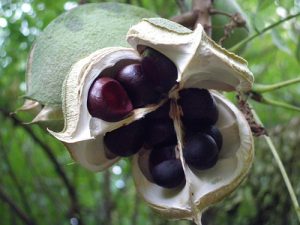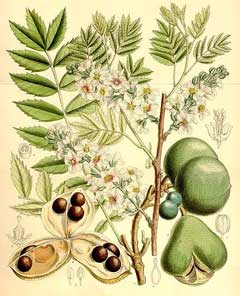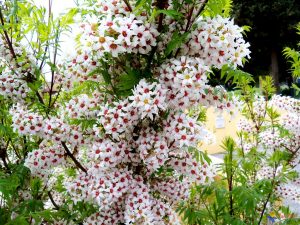 This deciduous shrub or small tree is slow-growing, but once established it will produce edible, dark green leaves that turn bright yellow in Autumn. It has beautiful, fragrant flowers that are also edible, and seeds that are used for food and cooking oil. The oil is also being evaluated for biodiesel. This ornamental plant is also fairly drought tolerant and may also be a food source for beneficial insects. It is almost unknown outside of Asia, but this plant seems to be growing in popularity. While Yellowhorn will make an interesting and useful addition to a Forest Garden, I think there is a lot of potential for this as a major crop.
This deciduous shrub or small tree is slow-growing, but once established it will produce edible, dark green leaves that turn bright yellow in Autumn. It has beautiful, fragrant flowers that are also edible, and seeds that are used for food and cooking oil. The oil is also being evaluated for biodiesel. This ornamental plant is also fairly drought tolerant and may also be a food source for beneficial insects. It is almost unknown outside of Asia, but this plant seems to be growing in popularity. While Yellowhorn will make an interesting and useful addition to a Forest Garden, I think there is a lot of potential for this as a major crop.
- The genus name, “Xanthoceras” means “yellow horn”. This is in reference to the orange-yellow, horn/claw-like appendages between the petals.
- Yellowhorn fruit is green, round to pear-shaped, and up to 2.5 (6 cm) long.
- The fruit splits into three sections to release the seeds.
- There are 6-18 seeds per fruit, and each seed is about the size of a pea 0.6 inches (1.5 cm). The seeds are brown to purplish in color.
- The flowers are white, about 1 inch (2.5 cm) in diameter, and the yellow center will change to red/maroon when older (once source states that the color change occurs after pollination).
- One source stated that the fruit is 40% oil, and the seed alone is 72% oil (60% of which is Omega 6).
| Edible Uses | |
 Edible Parts: Flowers; Leaves; Seed. Edible Parts: Flowers; Leaves; Seed.Edible Uses:Flowers – cooked[2, 105, 183]. They are usually boiled[179]. Leaves – cooked[2, 105, 183]. They are usually boiled[179]. Seed – cooked[2, 105, 177]. The seed is about the size of a pea, it is quite sweet[183], with a taste like a sweet chestnut[178]. The seed is husked and then ground into a powder and boiled[179]. |
It is available here in a pot
